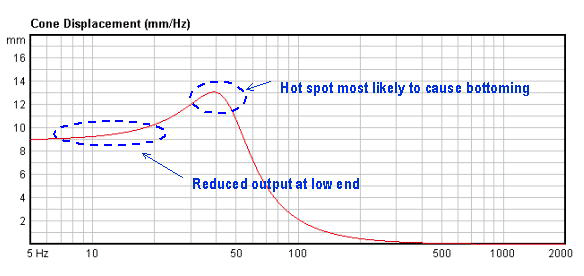Brian,
Take a look at my simulation with MJK's spreadsheet in this thread, which will illustrate my argument: http://www.audiocircle.com/index.php?topic=51217.40 
/Erling
Erling,
If I am not mistaken, your approach is very similar to Carver's approach. Did a google search on "carver amazing" and found
http://www.stereophile.com/floorloudspeakers/290carver/. It is an old article decribing the rationale used by Carver.
[EDIT] If you understand what I have stated earlier about the divergence of Q values, whatever you come up as the greatest and flatest response, I can implement that in the FR, independent of my physical parameters. However, the physical parameters should not have Q value higher than 1.0. This is because this

Now that hot spot is at the passband and one will experience bottoming far more often than a 10hz bottoming or 2hz bottoming unless he reduces the power which affects the output below and above your fs frequency. That is what Carver has not told us. You cannot see that in the frequency response. Come think of it, the divergence of Q value along 3 different axises (physical, instrinsic, frequency response) enable us to do a lot more. We have a switch let us switch between 14/20/28hz roll-off, we have another switch provides damping with Q value of 0.5/0.7/1.1. Your recommendation of 1.1 is in there, anyone can try that. However, my goal is to do something differently. As with a lot of technologies in the past, what Carver used was handicapped by the following two objectives: 1) no EQ is required and 2) efficiency needs to match the rest of the speakers. Another example is Isobarik. I kept asking people to give me an efficiency comparison between a sealed enclosure of two drivers and an Isobarik with the same amp output and enclosure size. If one can show me mathematically or by simulation that the latter produces more output with the same wattage and enclosure size, I will change my dual driver kit to target only for Isobarik.
How loud this system can play down at 14hz? That is related to physical parameters and that we have done the best. Personally what I think is important is how loud we can play at 20hz. If you can use a wider baffle, it helps a lot. Let us say at 20hz, each woofer can put out 15m one way excursion (peak is definitely higher than this), this is about 102db for a 12" woofer without considering cancellation loss. If you have 3 of them, that is 10db increase. But now you have to subtract loss. If we assume the baffle is large enough, your 3db shelving down due to cancellation starts at 60hz. When it is down to 20hz, it is roughly 3x loss which is 10db. So you get back to 102db, same as sealed enclosure with one driver.
If you know how to solder, you can even experiment after you bought the kit because the shelving function involves only one cap and one resistor. Based on the math, one can see the loss at 14hz is about another 3db as compared to sealed. I have a lot of customers use a single 12" in sealed box and are happy with the output. If one is a purist with deep pocket, you can drive 4 units with a single 370WRMS amp. It can extract every juice out of the driver. We have plan these ideas from the very beginning, considering how customers can upgrade, what wattage we target at,...ect. When we consider bottoming, we consider the situation even when users accidentally turn up the volume or the movie contains unexpectedly loud scense so that the amp is already into clipping. Our goal is not hear the driver bottom out. As a matter of fact, the foundation of this OB is actually based on our sealed box results. I was hoping I can increase the fs of the driver higher than 24hz by reducing even cone weight. I have done my best. Anyway, in our sealed servo sub, the driver after loading into the enclosure has a fs of 40hz and Q value of 0.9-1.0. It plays down to 14hz at moderate volume. If one really wants to play loud, set the roll-off to 28hz and damping to low. If that is still not enough, we have larger driver
